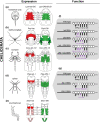Dual Functions of labial Resolve the Hox Logic of Chelicerate Head Segments
- PMID: 36798978
- PMCID: PMC10015621
- DOI: 10.1093/molbev/msad037
Dual Functions of labial Resolve the Hox Logic of Chelicerate Head Segments
Abstract
Despite an abundance of gene expression surveys, comparatively little is known about Hox gene function in Chelicerata. Previous investigations of paralogs of labial (lab) and Deformed (Dfd) in a spider have shown that these play a role in tissue maintenance of the pedipalp segment (lab-1) and in patterning the first walking leg identity (Dfd-1), respectively. However, extrapolations of these data across chelicerates are hindered by the existence of duplicated Hox genes in arachnopulmonates (e.g., spiders and scorpions), which have resulted from an ancient whole genome duplication (WGD) event. Here, we investigated the function of the single-copy ortholog of lab in the harvestman Phalangium opilio, an exemplar of a lineage that was not subject to this WGD. Embryonic RNA interference against lab resulted in two classes of phenotypes: homeotic transformations of pedipalps to chelicerae, as well as reduction and fusion of the pedipalp and leg 1 segments. To test for combinatorial function, we performed a double knockdown of lab and Dfd, which resulted in a homeotic transformation of both pedipalps and the first walking legs into cheliceral identity, whereas the second walking leg is transformed into a pedipalpal identity. Taken together, these results elucidate a model for the Hox logic of head segments in Chelicerata. To substantiate the validity of this model, we performed expression surveys for lab and Dfd paralogs in scorpions and horseshoe crabs. We show that repetition of morphologically similar appendages is correlated with uniform expression levels of the Hox genes lab and Dfd, irrespective of the number of gene copies.
Keywords: Hox1; Arthropoda; Opiliones; Xiphosura; serial homology; tritocerebrum.
© The Author(s) 2023. Published by Oxford University Press on behalf of Society for Molecular Biology and Evolution.
Figures






Similar articles
-
A conserved genetic mechanism specifies deutocerebral appendage identity in insects and arachnids.Proc Biol Sci. 2015 Jun 7;282(1808):20150698. doi: 10.1098/rspb.2015.0698. Proc Biol Sci. 2015. PMID: 25948691 Free PMC article.
-
The genome of a daddy-long-legs (Opiliones) illuminates the evolution of arachnid appendages.Proc Biol Sci. 2021 Aug 11;288(1956):20211168. doi: 10.1098/rspb.2021.1168. Epub 2021 Aug 4. Proc Biol Sci. 2021. PMID: 34344178 Free PMC article.
-
Distal-less and dachshund pattern both plesiomorphic and apomorphic structures in chelicerates: RNA interference in the harvestman Phalangium opilio (Opiliones).Evol Dev. 2013 Jul-Aug;15(4):228-42. doi: 10.1111/ede.12029. Epub 2013 May 14. Evol Dev. 2013. PMID: 23809698
-
The Impact of Whole Genome Duplication on the Evolution of the Arachnids.Integr Comp Biol. 2023 Sep 15;63(3):825-842. doi: 10.1093/icb/icad050. Integr Comp Biol. 2023. PMID: 37263789 Review.
-
The Evolutionary Biology of Chelicerata.Annu Rev Entomol. 2025 Jan;70(1):143-163. doi: 10.1146/annurev-ento-022024-011250. Epub 2024 Dec 19. Annu Rev Entomol. 2025. PMID: 39259983 Review.
Cited by
-
Divergent Hox cluster collinearity in horned beetles reveals adult head patterning function of labial.Dev Biol. 2025 Oct;526:70-81. doi: 10.1016/j.ydbio.2025.07.002. Epub 2025 Jul 3. Dev Biol. 2025. PMID: 40617473
-
Role of the Hox Genes, Sex combs reduced, Fushi tarazu and Antennapedia, in Leg Development of the Spider Mite Tetranychus urticae.Int J Mol Sci. 2023 Jun 20;24(12):10391. doi: 10.3390/ijms241210391. Int J Mol Sci. 2023. PMID: 37373537 Free PMC article.
References
-
- Angelini DR, Liu PZ, Hughes CL, Kaufman TC. 2005. Hox gene function and interaction in the milkweed bug Oncopeltus fasciatus (Hemiptera). Dev Biol. 287:440–455. - PubMed
-
- Arnaud F, Bamber RN. 1988. The Biology of Pycnogonida. Adv Mar Biol 24:1–96.
Publication types
MeSH terms
Substances
LinkOut - more resources
Full Text Sources
Miscellaneous

